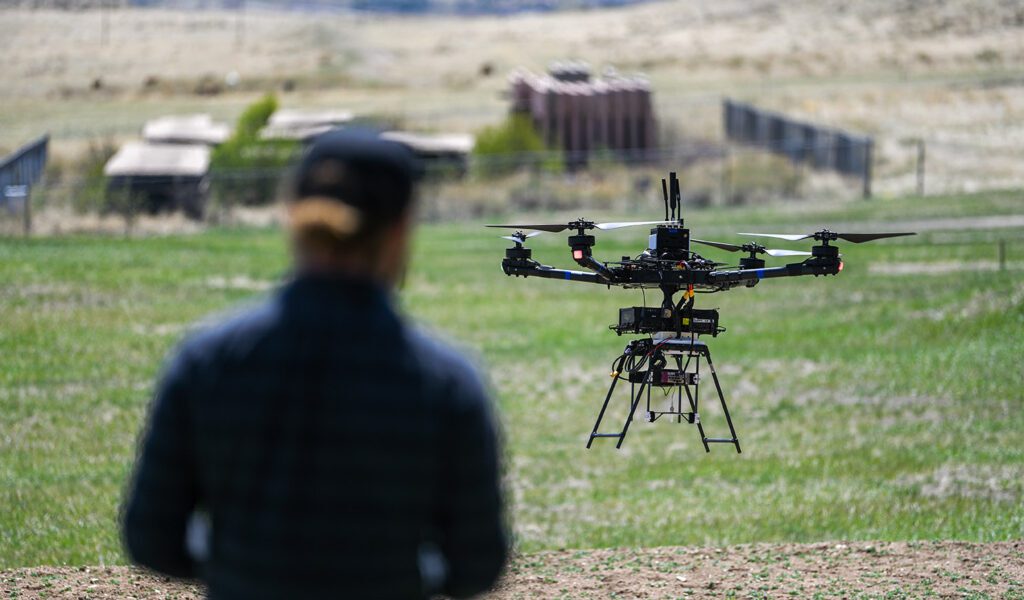
Strategic partners Lockheed Martin and Verizon this year have demonstrated the capture and seamless, secure transmission and processing of intelligence, surveillance and reconnaissance (ISR) data in real-time over private and public next-generation wireless networks, showcasing Lockheed Martin’s efforts to develop 5G.MIL capabilities for the digital all-domain battlespace.
The demonstrations in May and September have involved the use of 5G-enabled small quadcopter drones flying simulated missions and capturing streaming video and high-band digitized radio frequency data to geolocate ground-based targets on the battlefield to enhance situational awareness for deployed troops and command and control leadership, Dan Rice, vice president of 5G.MIL Programs at Lockheed Martin, said during a virtual media roundtable on Tuesday.
The demonstrations showcased three technology capabilities for military applications, he said.
“The high-speed, real-time transfer of that data from multiple drones simultaneously through those 5G private networks is an example of the applicability of 5G.MIL and edge processing technology to support military forces’ increased situational awareness on the battlespace,” Rice said. “The radio frequency data that we transferred enabled advanced signal processing algorithms to be executed at the tactical edge.”
The second area was the use of the technology to detect and geolocate low-power RF signals that adversaries may use for communications, sensing and jamming, Rice said. That data was captured by the drones, transmitted over a private network, and processed by Lockheed Martin algorithms at the tactical edge to geolocate the sources as part of a larger common operating picture, he said.
Finally, during the exercises the companies securely transmitted the data over the private 5G network tailored for military missions in austere environments and a surrogate public network, Rice said. The ability to securely combine the private military and public networks will extend the range of the 5G.MIL technologies and “creates unique opportunities for the military to extend and diversify its communication pathways,” he said.
The key to these advanced, seamless capabilities “across the military depends on the adoption of an open architecture 5G and military communications systems network of networks,” Rice said, highlighting that this is what Lockheed Martin’s 5G.MIL Program is developing.
5G networks began rolling out in the U.S. several years ago and offer increased bandwidth, lower latency and more advanced edge processing than 4G networks. Moreover, 5G allows the “seamless handovers” between the private and public networks and “orchestrate data and applications back to enterprise level clouds,” Rice said.
Srini Kalapala, senior vice president for Technology and Product Development at Verizon, said private 5G networks for the military will eventually allow the ability to configure different priorities and outcomes for users and devices depending on sensitivities. This will be tested out in the coming months, he said.
5G will also enable the connection of many more devices and sensors in a smaller footprint, Kalapala said.
“And with the low latency and edge computing, all of these IoT sensors that were collecting all of this data will now be able to throw the data quickly to the edge and you’ll be able to apply AI or whatever other mechanisms and get the right outcomes so that you can then put it back into whatever activity that they’re trying to do,” he said. “So that’s what makes 5G lot more attractive.”
The first round of demonstrations in May involved using the drones and edge processing to locate and identify the RF emitters and stream the video data of a ground target, Rice said. From mid-September on, the team is doing the same thing against moving ground targets, he said.
Next, the companies plan to demonstrate the geolocation and tracking of an aerial target in real-time by putting an RF emitter on another drone, Rice said. This exercise will begin this fall and move into 2023.
Then, the technology will be put on “longer-range fixed-wing assets” to “extend the operational envelope of where we can do this detection and geolocation,” he said. “So, that will stress both the range of our sensing capability, the range and performance of the 5G networks that we’re using to move the information back to that edge processing capability.”
Verizon supplied two of its private network nodes on-site for the testing, which occurred at Lockheed Martin’s 5G test range in Waterton, Colo.
This article was first published by Defense Daily, a sister publication to Avionics International, to view the original version, click here.>>